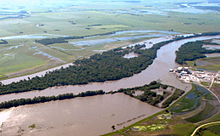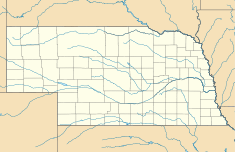- Cooper Nuclear Station
-
Cooper Nuclear Station 
The reactor complex on June 15, 2011 during the 2011 Missouri River FloodsLocation of Cooper Nuclear Station Country United States Location Nemaha County, near Brownville, Nebraska Coordinates 40°21′43″N 95°38′29″W / 40.36194°N 95.64139°WCoordinates: 40°21′43″N 95°38′29″W / 40.36194°N 95.64139°W Status Operational Commission date July 1, 1974 Licence expiration January 18, 2034 Owner(s) Nebraska Public Power District (NPPD) Operator(s) Entergy Nuclear Architect(s) Burns & Roe Reactor information Reactors operational 1 × 770 MW Reactor type(s) boiling water reactor Reactor supplier(s) General Electric Power generation information Capacity factor 88.4% (2008) Net generation 5,964 GW·h Website
www.nppd.com/.../cnsAs of 2010-12-01 Cooper Nuclear Station (CNS) is a boiling water reactor (BWR) type nuclear power plant located on a 1,251-acre (5.1 km²) site near Brownville, Nebraska between Missouri River mile markers 532.9 and 532.5. It is the largest single-unit electrical generator in Nebraska.
Contents
Description
CNS is owned and operated by the Nebraska Public Power District (NPPD), a political subdivision of the state of Nebraska. Management support services for Cooper Nuclear Station is provided by Entergy Nuclear, the nation's second largest nuclear power operator.
The facility is named after Humboldt natives Guy Cooper, Jr., and Guy Cooper, Sr.[1] The senior Cooper's father, O. A. Cooper, built the first electrical plant in Humboldt in 1890; the two Guy Coopers served a total of 27 years on the board of NPPD and its predecessor agency, Consumers Public Power District.[2]
CNS was first put into operation in July 1974 and generates approximately 800 megawatts (MWe) of electricity. The plant consists of a General Electric BWR/4 series reactor plant and a Westinghouse turbine generator. The plant has a Mark I containment system.
In 1998, CNS was the first plant in the United States to load nuclear fuel containing uranium that had been provided under the Megatons to Megawatts Program, in which uranium removed from nuclear weapons of the former Soviet Union was turned into low-enriched uranium and then into fuel.[3]
In September 2008, NPPD applied to the U.S. Nuclear Regulatory Commission (NRC) for a renewal of the operating license for CNS, extending it for an additional twenty years.[4] In November 2010 CNS received its license renewal, which was the 60th renewal license to be issued by the NRC.[5]
An agreement was approved in January 2010 by NPPD to extend Entergy's management support services until January 2029. The original contract between the companies, signed in 2003, was for the remaining years of the plant's original operating license, which ran until January 18, 2014.
Surrounding population
The Nuclear Regulatory Commission defines two emergency planning zones around nuclear power plants: a plume exposure pathway zone with a radius of 10 miles (16 km), concerned primarily with exposure to, and inhalation of, airborne radioactive contamination, and an ingestion pathway zone of about 50 miles (80 km), concerned primarily with ingestion of food and liquid contaminated by radioactivity.[6] In 2010, the population within 10 miles of Cooper was 4,414; the population within 50 miles was 163,610. Cities within the 50-mile radius include Nebraska City, with a population of 7,289, located 25 miles (40 km) from the plant.[7][8]
Seismic risk
The Nuclear Regulatory Commission's estimate of the risk each year of an earthquake intense enough to cause core damage to the reactor at CNS was 1 in 142,857, according to an NRC study published in August 2010.[9][10]
Events
At 0402 CDT on 6/19/2011 a Notification of Unusual Event was declared due to the elevation of the Missouri River reaching 899.1 feet above mean sea level. This is above the Emergency Action Level HU1.5 elevation of 899 feet. Later, the Missouri River reached 900.6 feet on 6/23/2011 while elevation of 902 feet is the alert level for the plant.[11] [12] The plant left the emergency status at 9:47 a.m., July 12 after the river dropped to 895.8 feet—3 feet below the emergency status level.[13]
See also
Notes
- ^ "Cooper Nuclear Station". Nebraska Public Power District. Retrieved 2011-05-04.
- ^ "A Closer Look at Cooper Nuclear Station". Nebraska Public Power District brochure; online at Iowa Homeland Security & Emergency Management website. Retrieved 2011-05-04.
- ^ DeVolpi, Alexander; Minkov, Vladimir E. et al (2005). Nuclear Shadowboxing: Legacies and Challenges. 2. Kalamazoo, Mich.: DeVolpi. p. VII-54. ISBN 0-9777734-1-8. http://books.google.com/books?id=gJHtHlm9r4YC&printsec=frontcover&source=gbs_ge_summary_r&cad=0#v=onepage&q&f=false.
- ^ "Cooper Nuclear Station". License Renewal Application. U.S. Nuclear Regulatory Commission (NRC). October 22, 2008. http://www.nrc.gov/reactors/operating/licensing/renewal/applications/cooper.html. Retrieved 2008-11-25.
- ^ "Nuclear power plant receives 20-year operating license renewal". Power-Gen Worldwide (PennWell Corporation). November 30, 2010. http://www.powergenworldwide.com/index/display/articledisplay/9629112156/articles/powergenworldwide/nuclear/o-and-m/2010/11/Cooper-nuclear-license-renewed.html. Retrieved 2010-12-02.
- ^ http://www.nrc.gov/reading-rm/doc-collections/fact-sheets/emerg-plan-prep-nuc-power-bg.html
- ^ Dedman, Bill (April 14, 2011), Nuclear neighbors: Population rises near US reactors, msnbc.com, http://www.msnbc.msn.com/id/42555888/ns/us_news-life/ Accessed 2011-05-01.
- ^ Drozd, David. "Nebraska Incorporated Place Census Populations with Changes and Percent Changes: 1980 to 2010". Center for Public Affairs Research, University of Nebraska—Omaha. Retrieved 2011-05-04.
- ^ Dedman, Bill (Mar. 17, 2011). "What are the odds? US nuke plants ranked by quake risk". msnbc.com. http://www.msnbc.msn.com/id/42103936/. Retrieved 2011-04-19.
- ^ Hiland, Patrick (Sep. 2, 2010). "Memorandum, Safety/Risk Assessment Results for Generic Issue 199, 'Implications of Updated Probabilistic Seismic Hazard Estimates in Central and Eastern United States on Existing Plants'". NRC. http://msnbcmedia.msn.com/i/msnbc/Sections/NEWS/quake%20nrc%20risk%20estimates.pdf. Retrieved 19 Apr. 2011.
- ^ Kehoe, Benjamin (Jun. 20, 2011). "Unusual event declared due to Missouri river flooding". United States Nuclear Regulatory Commission, NRC. http://www.nrc.gov/reading-rm/doc-collections/event-status/event/2011/20110620en.html#en46969. Retrieved 2011-06-23.
- ^ "Flood Facts and Information (June 2011)". Nebraska Public Power District, NPPD. June, 2011. http://www.nppd.com/flood/powerplants.asp. Retrieved 2011-06-23.
- ^ http://journalstar.com/news/local/article_75ef1986-c94b-59c1-a8db-cdd682f33438.html
External links
- Nebraska Public Power District
- "Cooper Nuclear Station". Nebraska Public Power District (NPPD). http://www.nppd.com/About_Us/Energy_Facilities/facilities/cns.asp. Retrieved 2008-11-25.
- "Cooper Nuclear Station". Entergy Nuclear. http://www.entergy-nuclear.com/plant_information/cooper.aspx. Retrieved 2008-11-25.
- "Nebraska Nuclear Profile". Energy Information Administration, U.S. Department of Energy (DOE). September 29, 2008. http://www.eia.doe.gov/cneaf/nuclear/state_profiles/nebraska/ne.html#_ftn1. Retrieved 2010-12-01.
- "Cooper Boiling Water Reactor". Operating Nuclear Power Reactors. U.S. Nuclear Regulatory Commission (NRC). February 10, 2011. http://www.nrc.gov/info-finder/reactor/cns.html. Retrieved 2011-03-02.
Categories:- Nuclear power stations in the United States
- Nuclear power plants in Nebraska
- Buildings and structures in Nemaha County, Nebraska
- 1974 establishments
Wikimedia Foundation. 2010.

